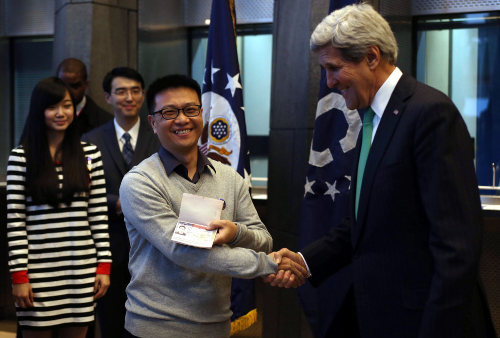|
 |
|
A NEW BEGINNING: U.S. Secretary of State John Kerry hands out the first 10-year visas to a group of Chinese citizens in a ceremony at the U.S. Embassy in Beijing on November 12 (WANG SHEN) |
Starting November 12, the concluding day of the Asia-Pacific Economic Cooperation (APEC) summit in Beijing, a new visa policy between China and the United States was officially put into operation. Under the new measures, the two nations promise to grant each other's citizens business or tourist visas with a maximum validity period of 10 years, while student exchange visas will remain valid up to five years.
The new policy means Chinese citizens who travel back and forth between China and the United States will benefit from the longer validity periods and will no longer have to apply and pay application fees on a yearly basis, experts say.
Previously, business travelers, tourists and students had to renew their visas annually, incurring financial costs, long waiting periods and piles of paperwork. According to the U.S. Embassy to China, each visa application costs $160, or nearly 1,000 yuan. Total visa fees amounted to 1.7 billion yuan ($276.42 million) last year.
"The new visa deal will benefit about 80 percent of travelers between the two countries," Huang Ping, Director of the Consular Department of the Ministry of Foreign Affairs (MFA), said at a news briefing on November 14.
The ministry's statistics show that 4.05 million people traveled between China and the United States last year and 70-80 percent of them were business people and tourists. "It means that an average of more than 10,000 people are traveling between the two countries every day," Huang said.
"China has spared no efforts to promote visa facilitation with other countries. We hope the agreement with the United States can set an example for future consultations between China and other countries," he added.
Li Haidong, a professor of U.S. studies at Beijing-based China Foreign Affairs University, said the reciprocal visa arrangement reflects the breakthroughs China has made on visa applications with developed countries.
According to the MFA, China has signed mutual visa exemption agreements with nearly 90 countries and reached 53 visa simplification agreements with 39 countries.
A total of 37 countries and regions have agreed to grant Chinese citizens visas on arrival, while eight countries and regions unilaterally allow Chinese citizens to enter without a visa.
Jia Xiudong, an international affairs researcher with the China Institute of International Studies, said visa facilitation is the result of growing demand, both in China and foreign countries.
"China's stunning economic development has made it possible for more and more of its citizens to travel abroad," Jia said.
Good omens for tourism
Experts say extending the terms of tourist visas will boost Chinese people's enthusiasm for visiting the United States.
The country is already included on the top10 list of most popular location for Chinese travelers, but the number of tourists traveling there remains small compared to closer countries such as South Korea and Thailand. According to the White House, fewer than 2 percent of travelers choose the United States as their holiday destination each year, mainly owing to factors such as distance, travel costs and visa issues.
The new deal is set to facilitate longer and more in-depth tours, as travelers will be allowed to enter the United States multiple times. "The United States has a lot to offer Chinese tourists, including exotic natural scenery, such as Yellowstone National Park, as well as various theme parks, such as Disneyland," said Jiang Yiyi, head of the China Tourism Academy's international tourism development institute.
"This policy will harness the colossal and growing Chinese travel market for the direct benefit of U.S. job creation, exports and economic growth," said Roger Dow, Chief Executive of industry trade group of the U.S. Travel Association. "The effects will be both strong and immediate."
Tourism officials in the United States said Chinese visitors are the fastest-growing overseas group traveling to the country. Last year, 1.8 million Chinese tourists visited the United States, contributing $21.1 billion to the American economy and supporting more than 100,000 American jobs, according to the U.S. Department of Commerce.
Thanks to the new visa policy, the number of Chinese visitors will jump 21 percent this year, the White House predicted. By 2021, the United States will see 7.3 million Chinese travelers, who will spend $85 billion there and create 440,000 jobs.
| 